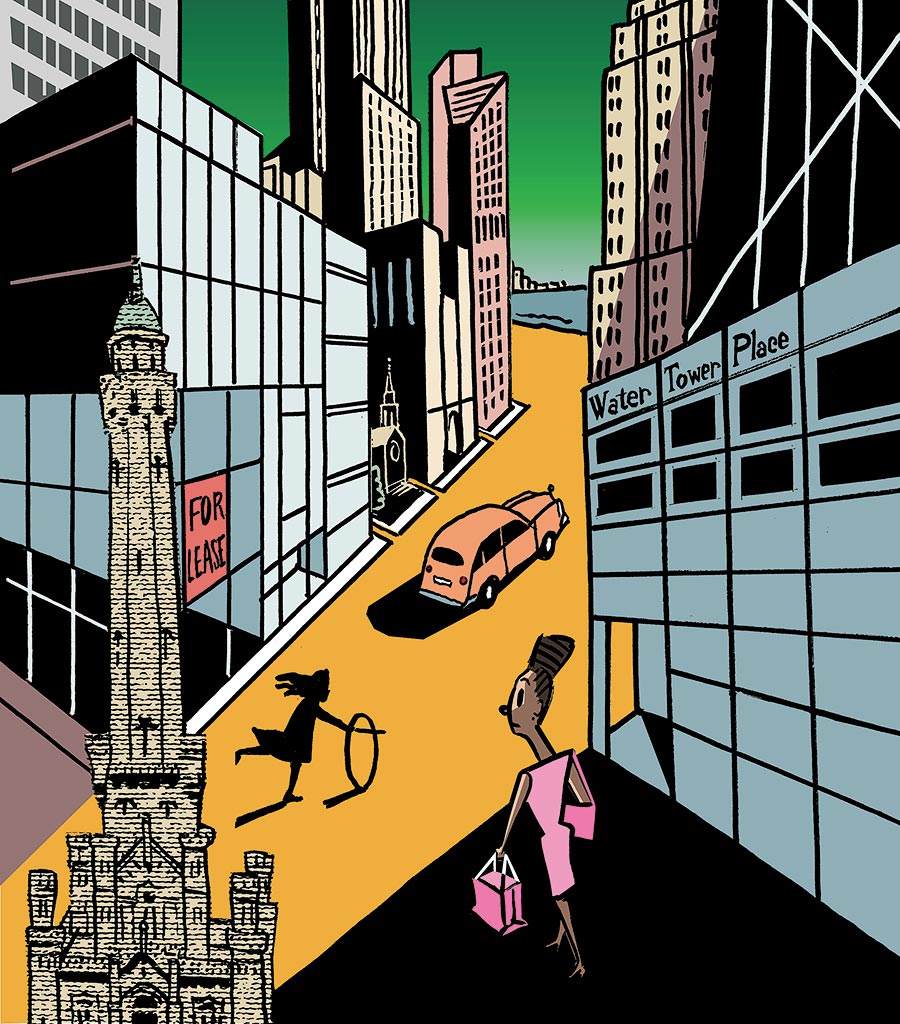Little more than a decade ago, Water Tower Place was the ultimate destination for shoppers itching to spend money along the Magnificent Mile. The gray-marble-clad building on North Michigan Avenue was home to retail titans of yore, including Lord & Taylor and Marshall Field’s. The eight-story mall had scores of brand-name shops, chic boutiques, and a bustling food court with a dozen stations each serving a distinct cuisine.
These days, the department stores are gone, leaving vacant spaces. Other familiar retailers have fled, including Gap and Banana Republic, making way for sports jersey and T-shirt shops. The food court’s highlight is an M Burger. “Everybody would love Water Tower Place to go back to what it was,” says Alderman Brian Hopkins, whose 2nd Ward includes part of the Mag Mile. “The reality is, that’s not going to happen.”
That doesn’t just apply to Water Tower Place. The entire Mag Mile is in need of revitalization, being primarily responsible for the 22 percent retail vacancy rate (compared with 4 percent in 2016) and a 23 percent year-over-year drop in city sales tax revenues in its affluent 60611 ZIP code, according to data cited by the Urban Land Institute Chicago, a nonprofit enlisted by the city and business interests to examine the Mag Mile’s options.
Like other prestigious shopping districts, the Mag Mile is coping with online rivals and a business-crushing pandemic; after the recent rash of shootings, assaults, carjackings, and “smash-and-grab” thefts, it’s also now seen as a dangerous place to visit. So a panel of urban planners, architects, and civic and business experts has joined with City Hall to work on a rescue strategy.
One early result: A report commissioned from ULI Chicago that recommends remaking the Mag Mile into a pedestrian-friendly promenade, with wider sidewalks, extended green spaces, and “pocket parks” and plazas for wandering, lounging, or grabbing a drink. The ULI Chicago panel culled ideas from the Champs-Élysées in Paris, Bandera Street in Santiago, Chile, and New York’s High Line and Bryant Park. “Mag Mile is a thoroughfare, so people go to one or two locations and move on,” says Cindy McSherry, ULI Chicago’s executive director. “We’re thinking about ways of spending an afternoon there. Shopping is only a piece of what you do.”
Shopping, however, is a vital driver, and the ULI Chicago plan calls for dividing the Mag Mile into four “retail zones.” The far north, from Oak Street to Delaware Place, would feature luxury boutiques like those on Oak — Armani, Chanel, Hermès, Prada — where the retail vacancy rate is just 3 percent, according to CBRE, which tracks business leasing. Moving south, the area between Delaware Place and Chicago Avenue would feature “experiential” stores (think of the Immersive Van Gogh exhibit, the Legoland Discovery Center, theaters, and beverage tasting rooms). The mile’s midsection, between Chicago and Grand Avenues, would accommodate department stores similar to current tenants Nordstrom and Neiman Marcus. The southern point, between Grand and the Chicago River, would focus on the Apple Store and tourist-oriented vendors and operators along the Riverwalk and revamped Pioneer Court.
The Mag Mile could attract young people by offering “high-concept restaurants, edgy fashion stores, forward-thinking furniture shops,” and even corporate headquarters similar to the Fulton Market district, contends Keely Polczynski, a senior vice president at CBRE. “You don’t go to Michigan Avenue to see the same things you see in any mall,” she says.
Moreover, the Mag Mile’s mission calls for more residential buildings beyond the Tribune Tower, which has been converted to tony condos. Underused office space could be repurposed as student housing for nearby universities (Loyola’s downtown campus is only a block from Water Tower Place) or as “medical hotels” for employees, students, and the families of patients at Northwestern Memorial Hospital, says ULI Chicago’s McSherry.
One issue that can’t wait, though, is crime. “The No. 1 concern in real estate is location, location, location,” says Alderman Hopkins. “Well, we’ve got location already. So the top three things are public safety, public safety, public safety.”
A recent midmorning trip to the Mag Mile provided a glimpse of such woes. Two police SUVs with blue lights flashing were parked on the Michigan Avenue median. An armed security guard stood outside Gucci. Water Tower Place posted a warning that on Fridays and Saturdays after 4 p.m. anyone under 17 must be accompanied “at all times” by an adult.
Mag Mile merchants have agreed to pay more for surveillance and security, and Illinois passed a law this year targeting culprits of organized smash-and-grabs such as those that hit the street in 2019. Violators who steal more than $300 of goods could face up to 10 years in prison. The Mag Mile’s criminal travails “became a flashpoint or awakening for legislators,” says Rob Karr, CEO of the Illinois Retail Merchants Association.
Kimberly Bares, CEO of the Magnificent Mile Association, which advocates for the business district, says the ULI Chicago study is “a beginning, not an end” and there’s more to discuss, including how to pay for the makeover. Lowering real estate taxes on some Michigan Avenue buildings would be a start, she says. Owners could reinvest that freed-up cash in their properties.
Public funding may help pay for enhanced safety, says Hopkins. But there’s “no appetite” for subsidies to retailers, nor for a Mag Mile tax increment financing district — an investment mechanism meant to bankroll redevelopment in blighted areas, not places like North Michigan Avenue, he stresses.
Time is of the essence. Recently, Water Tower Place’s owner, Brookfield Properties, handed the 47-year-old mall back to its lender, MetLife. In other words, the shopping center is now worth less than the $300 million owed on it — another sign that the Magnificent Mile has lost its magnificence.



